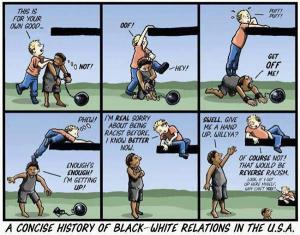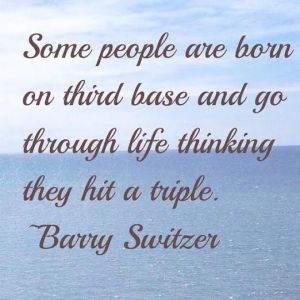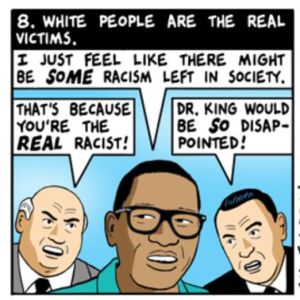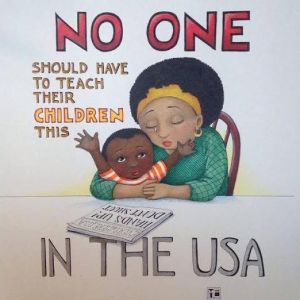White Fragility
by
Robin DiAngelo [a white woman]
(with minor editing by me)
White people in North America live in a social environment that protects & insulates them from race-based stress. This insulated environment of racial protection builds white expectations for racial comfort, while at the same time lowering the ability to tolerate racial stress, leading to what I refer to as White Fragility.
White Fragility is a state in which even a minimum amount of racial stress becomes intolerable, triggering a range of defensive moves. These moves include the outward display of emotions such as anger, fear & guilt, and behaviors such as argumentation, silence & leaving the stress-inducing situation. These behaviors, in turn, function to reinstate white racial equilibrium. This document explicates the dynamics of White Fragility.
I am a white woman. I am standing beside a black woman. We are facing a group of white people who are seated in front of us. We are in their workplace, and have been hired by their employer to lead them in a dialogue about race. The room is filled with tension and charged with hostility. I have just presented a definition of racism that includes the acknowledgment that whites hold social & institutional power over people of color [PoC]. A white man is pounding his fist on the table. His face is red and he is furious. As he pounds he yells, “White people have been discriminated against for 25 years! A white person can’t get a job anymore!” I look around the room & see 40 employed people, all white. There are no PoC in this workplace. Something is happening here, and it isn’t based in the racial reality of the workplace. I am feeling unnerved by this man’s disconnection with that reality & his lack of sensitivity to the impact this is having on my co-facilitator, the only person of color in the room. Why is this white man so angry? Why is he being so careless about the impact of his anger? Why are all the other white people either sitting in silent agreement with him or tuning out? We have, after all, only articulated a definition of racism.
White people in North America live in a social environment that protects & insulates them from race-based stress. Fine identifies this insulation when she observes “… how Whiteness accrues privilege & status; gets itself surrounded by protective pillows of resources and/or benefits of the doubt; how Whiteness repels gossip & voyeurism and instead demands dignity…” [Although white racial insulation is somewhat mediated by social class (with poor & working class urban whites being generally less racially insulated than suburban or rural whites), the larger social environment insulates & protects whites as a group through institutions, cultural representations, media, school textbooks, movies, advertising, dominant discourses, etc] Whites are rarely without these “protective pillows,” and when they are, it is usually temporary & by choice. This insulated environment of racial privilege builds white expectations for racial comfort, while at the same time lowering the ability to tolerate racial stress.
For many white people, a single required multicultural education course taken in college, or required “cultural competency training” in their workplace, is the only time they may encounter a direct & sustained challenge to their racial understandings. But even in this arena, not all multicultural courses or training programs talk directly about racism, much less address white privilege. It is far more the norm for these courses & programs to use racially coded language such as “urban,” “inner city,” & “disadvantaged” but to rarely use “white” or “over-advantaged” or “privileged.” This racially coded language reproduces racist images & perspectives while it simultaneously reproduces the comfortable illusion that race & its problems are what “they” have, not us.
Reasons why the facilitators of these courses & trainings may not directly name the dynamics & beneficiaries of racism range from the lack of a valid analysis of racism by white facilitators, personal & economic survival strategies for facilitators of color, and the overall pressure from management to keep the content comfortable & palatable for whites. However, if & when an educational program does directly address racism & the privileging of whites, common white responses include anger, withdrawal, emotional incapacitation, guilt, argumentation & cognitive dissonance (all of which reinforce the pressure on facilitators to avoid directly addressing racism).
So-called progressive whites may not respond with anger, but may still insulate themselves via claims that they are beyond the need for engaging with the content because they “already had a class on this” or “already know this.” These reactions are often seen in anti-racist education endeavors as forms of resistance to the challenge of internalized dominance. These reactions do indeed function as resistance, but it may be useful to also conceptualize them as the result of the reduced psychosocial stamina that racial insulation inculcates. I call this lack of racial stamina White Fragility.
Although mainstream definitions of racism are typically some variation of individual “race prejudice”, which anyone of any race can have, Whiteness scholars define racism as encompassing economic, political, social, and cultural structures, actions, and beliefs that systematize and perpetuate an unequal distribution of privileges, resources and power between white people and PoC. This unequal distribution benefits whites and disadvantages PoC overall and as a group. Racism is not fluid in the U.S.; it does not flow back & forth, one day benefiting whites & another day (or even era) benefiting PoC. The direction of power between whites & PoC is historic, traditional, normalized & deeply embedded in the fabric of U.S. society.
Whiteness itself refers to the specific dimensions of racism that serve to elevate white people over PoC. This definition counters the dominant representation of racism in mainstream education as isolated in discrete behaviors that some individuals may or may not demonstrate & goes beyond naming specific privileges. Whites are theorized as actively shaped, affected, defined & elevated through their racialization & the individual & collective consciousness’ formed within it. Recognizing that the terms I am using are not “theory-neutral ‘descriptors’” but theory-laden constructs inseparable from systems of injustice”, I use the terms white & Whiteness to describe a social process. Frankenberg defines Whiteness as multi-dimensional:
Whiteness is a location of structural advantage, of race privilege. Second, it is a ‘standpoint,’ a place from which White people look at ourselves, at others, and at society. Third, ‘Whiteness’ refers to a set of cultural practices that are usually unmarked and unnamed.
Frankenberg & other theorists use Whiteness to signify a set of locations that are historically, socially, politically & culturally produced, and which are intrinsically linked to dynamic relations of domination. Whiteness is thus conceptualized as a constellation of processes & practices rather than as a discrete entity (i.e. skin color alone). Whiteness is dynamic, relational, and operating at all times & on myriad levels. These processes & practices include basic rights, values, beliefs, perspectives & experiences purported to be commonly shared by all, but which are actually only consistently afforded to white people. Whiteness Studies begin with the premise that racism & white privilege exist in both traditional & modern forms, and rather than work to prove its existence, work to reveal it. This document explores the dynamics of one aspect of Whiteness & its effects, White Fragility.
Triggers
White Fragility is a state in which even a minimum amount of racial stress becomes intolerable, triggering a range of defensive moves. These moves include the outward display of emotions such as anger, fear, & guilt, and behaviors such as argumentation, silence & leaving the stress-inducing situation. These behaviors, in turn, function to reinstate white racial equilibrium. Racial stress results from an interruption to what is racially familiar. These interruptions can take a variety of forms and come from a range of sources, including:
• Suggesting that a white person’s viewpoint comes from a racialized frame of reference (challenge to objectivity)
• PoC talking directly about their racial perspectives (challenge to white racial codes)
• PoC choosing not to protect the racial feelings of white people in regards to race (challenge to white racial expectations and need/entitlement to racial comfort)
• PoC not being willing to tell their stories or answer questions about their racial experiences (challenge to colonialist relations)
• A fellow white not providing agreement with one’s interpretations (challenge to white solidarity)
• Receiving feedback that one’s behavior had a racist impact (challenge to white liberalism)
• Suggesting that group membership is significant (challenge to individualism)
• An acknowledgment that access is unequal between racial groups (challenge to meritocracy)
• Being presented with a person of color in a position of leadership (challenge to white authority);
• Being presented with information about other racial groups through, for example, movies in which PoC drive the action but are not in stereotypical roles, or multicultural education (challenge to white centrality).
In a white dominant environment, each of these challenges becomes exceptional. In turn, whites are often at a loss for how to respond in constructive ways. Whites have not had to build the cognitive or affective skills, or develop the stamina that would allow for constructive engagement across racial divides. Bourdieu’s concept of habitus may be useful here. According to Bourdieu, habitus is a socialized subjectivity; a set of dispositions which generate practices & perceptions. As such, habitus only exists in, through, and because of the practices of agents & their interaction with each other & with the rest of their environment. Based on the previous conditions & experiences that produce it, habitus produces & reproduces thoughts, perceptions, expressions & actions. Strategies of response to “disequilibrium” in the habitus are not based on conscious intentionality, but rather result from unconscious dispositions towards practice, and depend on the power position the agent occupies in the social structure.
White Fragility may be conceptualized as a product of the habitus, a response or “condition” produced & reproduced by the continual social & material advantages of the white structural position. Omi & Winant posit the U.S. racial order as an “unstable equilibrium,” kept equilibrated by the State, but still unstable due to continual conflicts of interests & challenges to the racial order. Using Omi & Winant’s concept of unstable racial equilibrium, white privilege can be thought of as unstable racial equilibrium at the level of habitus. When any of the above triggers (challenges in the habitus) occur, the resulting disequilibrium becomes intolerable. Because White Fragility finds its support in & is a function of white privilege, fragility & privilege result in responses that function to restore equilibrium & return the resources “lost” via the challenge – resistance towards the trigger, shutting down and/or tuning out, indulgence in emotional incapacitation such as guilt or “hurt feelings”, exiting, or a combination of these responses.
 Continued below: See White Fragility 2
Continued below: See White Fragility 2







